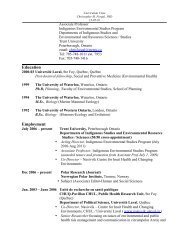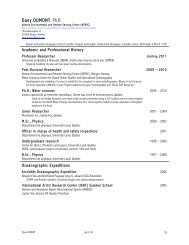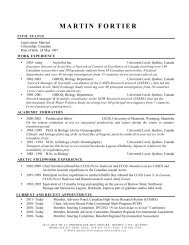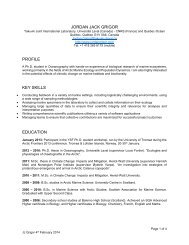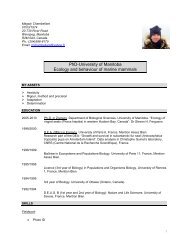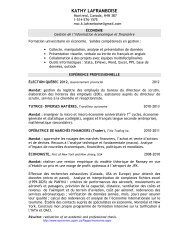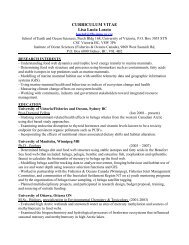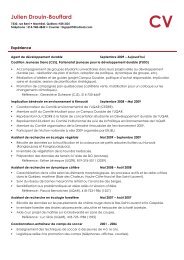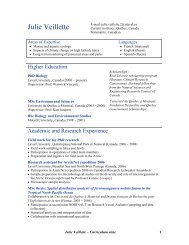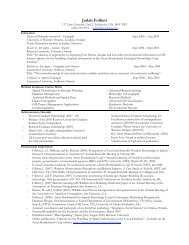Delphine Benoit Curriculum vitae - Arcticnet - Université Laval
Delphine Benoit Curriculum vitae - Arcticnet - Université Laval
Delphine Benoit Curriculum vitae - Arcticnet - Université Laval
Create successful ePaper yourself
Turn your PDF publications into a flip-book with our unique Google optimized e-Paper software.
<strong>Delphine</strong> <strong>Benoit</strong>Address : Département de Biologie,Pavillon Vachon,Université <strong>Laval</strong>,Québec, Qc,Canada, G1V 0A6Phone: +1 (418) 656-2131 # 5225e-mail: delphine.benoit.1@ulaval.ca<strong>Curriculum</strong> <strong>vitae</strong>Date of birth: 18 Sept. 1980Nationality: FrenchEducationSince fall 2004 Université <strong>Laval</strong>, CanadaPh.D. student in OceanographyOceanography, distribution and annual cycle of Arctic cod (Boreogadus saida) inthe Beaufort Sea: a hydroacoustic approach. Supervisors: Prof. Louis Fortier(Université <strong>Laval</strong>), Dr. Yvan Simard (UQAR-ISMER)2002 – 2003 Université de La Rochelle, FranceDEA (equivalent M.Sc. 2 nd year) Sustainable Exploitation of Coastal Ecosystems2001 – 2002 Université de Bretagne Occidentale - IUEM, Plouzané, FranceMaîtrise (equivalent M.Sc. 1 st year) Biology of populations and ecosystems, specialty“marine environment”2000 – 2001 Université de Bretagne Occidentale, Brest, FranceLicence (equivalent B.Sc. 3 rd year) Biology of populations and ecosystems1998 – 2000 Université Catholique de l’Ouest, Guingamp, FranceDEUG (equivalent B.Sc. 2 first years) BiologySummer course2007 Friday Harbour Laboratories, University of Washington, USA (5 weeks)Marine Bioacoustics. Dr. Chuck Greene and Dr. John HorneResearch experienceSince fall 2004 Ph.D. researchAnalysis of a one year acoustic data set to study Arctic cod’s distribution, behaviourand biomass in the Beaufort Sea. Use of complementary data (Irradiance, CTD,currents, zooplankton) for an integrated understanding of the ecology of thespecies, as part of the multidisciplinary CASES project.Referee for ICES Journal of Marine Science, Oil Spill Recovery Insitute2004 Extended studentship (6 months)Methodological development of acoustic data analysis in the framework of the RAPprogram (Adaptative responses of fish to environmental forcings). Impact study offisheries on two Malian lakes fish aggregations experiencing different fishingpressures. IRD, Brest - US004 ACCAPPELLA (Fisheries acoustics). Supervisors:Dr. E. Josse, Dr. A. Lebourges-Dhaussy2003 Master research (2 nd year) (5 months)In situ TS data analysis of different pelagic fish species from Bay of Biscaycompared with trawl samples. SIMFAMI European program. IRD, Brest - US004ACCAPPELLA (Fisheries acoustics) Supervisors: Dr. E. Josse, Dr. A. Lebourges-Dhaussy1
<strong>Delphine</strong> <strong>Benoit</strong><strong>Curriculum</strong> <strong>vitae</strong>2001 – 2002 Master research (1 st year)Seasonal variations of benthic macrofauna on a site highly colonized by slippersnail(Crepidula fornicata), Brest roadstead. UMR 6539, LEMAR, IUEM, PlouzanéSupervisor: L. GuérinSea workArcticNet 2005 CCGS Research Ice-breaker Amundsen, Late summer 2005 (42 days). HighCanadian Arctic. In charge of multifrequency echosounder (EK60) data recording,zooplankton samplingEXACHA04 R/V Thalassa, March 2004 (7 days). Bay of Biscay. Acoustics methodologicaltests, Sonar SR240 data recordingEXACHA03 R/V Thalassa, March 2003 (10 days). Bay of Biscay. Acoustics methodologicaltests. Acoustic survey, trawling.TROPHAL II R/V Thalassa, September 2002 (10 days). Bay of Biscay. Ph.D. student assistantfor water filtration and benthic trawl.INTRIGAS IV R/V Côtes de la Manche, June 2002 (4 days). Bay of Biscay. Ph.D. studentassistant for Hamon grab and benthic trawl.Research and technology skillsAcoustics • Echointegration,• Target-Strength extraction and fish tracking• Biomass estimation• EK60 Calibration (at sea and indoor experimental tank),• Software: Echoview, CH2, ER60, Movies+IT skills • Microsoft Office software• Sigmaplot, Systat, R, Adobe Photoshop, Surfer, MapViewerCommunication • Oral and poster presentations at national and international conferences• Languages: French (native), English (fluent), Spanish (intermediate)• Public communication ability: Aquarium guide (1998-2000 - Oceanopolis, Brest,France), Research Ice-breaker tours for non-initiates; workshop on Arctic marineresearch in a primary school (Commission scolaire des Découvreurs, Québec)AwardsTeaching • Student training in hydroacoustics at IRD (2004) and at <strong>Laval</strong> University (2008)Grant to participate in the ICES SEAFACTS symposium (Bergen, Norway) – 2008. Source: Symposiumsponsors. (2000€)Publication pay – 2007 – Source : Québec-Océan (500$)Grants to participate in the Marine Bioacoustics course at University of Washington – 2007. Source:Friday Harbour Laboratories and US Office of Naval Research (2500 US$)Ph.D. grants to attend the Arctic Frontiers Conference and following PhD workshop (Tromsø, Norway) –2007. Source: ArcticNet/ConocoPhillipsPoster contest price. Québec-Océan Annual Meeting – 2006 – Source: Québec-Océan (150$)Ph.D. admission pay – 2005 – Source : Université <strong>Laval</strong> (2000$)2
<strong>Delphine</strong> <strong>Benoit</strong><strong>Curriculum</strong> <strong>vitae</strong>Merit pay for master’s (DEA) – 2002-2003 – Source : French government (4000 €)InterviewsVancouverAquariumExhibition inQuébec cityLes ExplorateursRadio CanadaScientific contribution for « Canada’s Arctic in the grip of change » exhibition.October 2009, Vancouver, CanadaParticipation to show the importance of the Canadian Coast Guard in scientificresearch in the Arctic. Summer 2008, Québec city. As part of an exhibition on theCanadian Coast Guard.Article prepared by Marie-Claude Ouellet. “Une exploratrice en Arctique”. December2006« Les Années lumière ». Documentary prepared by Sophie-Andrée Blondin. “Perdrele Nord”. September 2005Thesis summaryMy research interest has centered marine ecosystem’s functioning, focussed on fish species andinteractions with their environment and other food web levels. For this purpose, hydroacoustics is anadvantageous and powerful tool, which I am interested to develop and improve.My previous researches enabled me to learn hydroacoustics methods (e.g. TS extraction, fish tracking,echointegration, calibration) applied to ecology of marine fish.For my Ph.D., the focus of my research is to provide new insights into the ecology of arctic cod(Boreogadus saida) in the Beaufort Sea. It is the dominant fish of the pelagic arctic ecosystem and a keylink in the transfer of biological production from the plankton to the vertebrate megafauna of the ArcticOcean. However, the large biomass of arctic cod that must exist to explain its prevalence in the diet ofseals, whales and sea birds has eluded detection by scientists. Moreover, little information is available onits distribution in relation with the regional oceanographic conditions. The acoustic data set that I am usingwas collected with a multi-frequency EK60 during the CASES 2003-2004 one-year multidisciplinaryexpedition on the CCGS Amundsen and represents a unique tool to further investigate the ecology of thiskey species. I use the CH2 software (developed by Simard et al.) to perform data conditioning andechointegration.First part of my research deals with overwintering long time-series. From December 2003 to May 2004,acoustic estimates of Arctic cod biomass at a 225-m deep station in central Franklin Bay (southeasternBeaufort Sea) increased progressively by two orders of magnitude, reaching maximum values of 2.7 kg m -3 and 55 kg m -2 in April. During accumulation in Franklin Bay, the fish occupied the lower part of the PacificHalocline (140 m to bottom), where the temperature-salinity signature (-1.4 °C to 0.3 °C; 33 to 34.8 PSU)corresponded to slope waters. Currents at 200 m along the western slope of Amundsen Gulf headed SSEin early winter, suggesting the passive advection of cod from southeastern Beaufort Sea into Franklin Bay.Retention in Franklin Bay against the general circulation resulted from the fish keeping at depth to reducepredation by diving seals and/or to benefit from relatively warm temperatures in the lower halocline. Basedon an average standing biomass of 11.23 kg m -2 , we estimated the total biomass of Arctic cod in FranklinBay in April at 30.3 Mt, a value that amply satisfies the requirements of predators. Dense accumulations ofArctic cod in embayments in winter likely play an important role in structuring the ecosystem of theBeaufort Sea. Understanding how climate change and the reduction of the sea ice cover will affect thestability of the oceanographic/behavioral accumulation process requires further research and modeling.Moreover, daily scale investigations showed that Arctic cod carry out Diel Vertical Migrations at depthunder the winter sea-ice cover. These migrations were triggered by the light/dark cycle. During the night, apart of the population migrated from the deep layer (< 140 m) to an intermediate layer (90 - 140 m), whilst3
<strong>Delphine</strong> <strong>Benoit</strong><strong>Curriculum</strong> <strong>vitae</strong>the most part remained below 140 m. The rhythm of migrations followed the evolution of the photoperiod.Migrations likely provided fish with an increased feeding success and reduced predation risk at night in theintermediate layer. This pattern occurred until the sun stopped setting in May when Arctic cod weredistributed between 50 and 150 m.During the open-water season, 3 months before and 3 months after the ship was iced-in, Arctic cod dwellin the 200-600 m layer on the continental shelves and accumulated on the slopes. A part of the populationseems to have been distributed in the first 50 m of the water column. This study is in progress and will bedetailed in future publication.Peer reviewed publications<strong>Benoit</strong>, D., Y. Simard, and L. Fortier (2008), Hydroacoustic detection of large winter aggregations ofArctic cod (Boreogadus saida) at depth in ice-covered Franklin Bay (Beaufort Sea), J Geophys. Res., 113,C06S90, doi:10.1029/2007JC004276.<strong>Benoit</strong> D., Y. Simard, J. Gagné, M. Geoffroy, L. Fortier (2010). From polar night to midnight sun:photoperiod, seal predation, and the diel vertical migrations of polar cod (Boreogadus saida) underlandfast ice in the Arctic Ocean. Polar Biology. doi: 10.1007/s00300-010-0840-x<strong>Benoit</strong>, D., Y. Simard, and L. Fortier, (in preparation). Habitat characteristics of Arctic cod during theopen-water season in the South-eastern Beaufort Sera. To be submitted to Polar BiologyConference CommunicationsTalks<strong>Benoit</strong>, D., Simard, Y., Gagné, J., Geoffroy, M., and Fortier, L. 2008. Seasonal and daily scale behaviourof Arctic cod winter aggregations under the sea-ice cover at a fixed station in Franklin Bay (Beaufort Sea).Arctic Change 2008 Conference, Québec City, Canada, 9-12 December<strong>Benoit</strong>, D., Simard, Y., and Fortier, L. 2008. Oceanography, distribution and annual cycle of Arctic cod(Boreogadus saida) in the Beaufort Sea: a hydroacoustic approach. ICES SEAFACTS Symposium,Bergen, Norway, 16-20 June 2008.<strong>Benoit</strong>, D., Simard, Y., and Fortier, L. 2007. Winter congregation of Arctic cod in Franklin Bay, AmundsenGulf, as revealed by hydro acoustics. Arctic frontiers Conference, Tromsø, Norway, 23-26 January.<strong>Benoit</strong>, D., Simard, Y., and Fortier, L. 2007. Hydro-acoustic detection of large winter aggregations ofArctic cod (Boreogadus saida) at depth in ice-covered Franklin Bay (Beaufort Sea). Canadian Arctic ShelfExchanges Study Annual Meeting, Québec City, 30 April – 2 MayYvan Simard, <strong>Delphine</strong> <strong>Benoit</strong>, Louis Fortier , Catherine Bédard, and Xavier Mouy. Acoustics, an effectivesuite of tools to explore the warming Arctic ocean. ICES-Working Group on Fisheries Acoustics Scienceand Technology, 2007 meeting Crowne Plaza Dublin Airport, Dublin, Ireland 23 rd to 27 th April 2007PostersGeoffroy, M., <strong>Benoit</strong>, D., and Fortier, L. 2009. In situ acoustic analysis of Arctic cod (Boreogadus saida)aggregations during winter in the Amundsen Gulf (southeastern Beaufort Sea). CFL all-hands meeting,Winnipeg, Canada, Nov. 2-54
<strong>Delphine</strong> <strong>Benoit</strong><strong>Curriculum</strong> <strong>vitae</strong>Geoffroy, M., <strong>Benoit</strong>, D., and Fortier, L. 2009. In situ acoustic analysis of Arctic cod (Boreogadus saida)aggregations during winter in the Amundsen Gulf (southeastern Beaufort Sea). ArcticNet Annual ScientificMeeting, Victoria, Dec. 8-11Geoffroy, M., <strong>Benoit</strong>, D., and Fortier, L. 2009. In situ acoustic analysis of Arctic cod (Boreogadus saida)aggregations during winter in the Amundsen Gulf (southeastern Beaufort Sea). APECS meeting(Association of Polar Early Career Scientists), Victoria, Canada, Dec. 4-8Geoffroy, M., <strong>Benoit</strong>, D., and Fortier, L. 2008. Could the immense aggregation of Arctic cod (Boreogadussaida) found in Franklin Bay extend to the Amundsen Gulf? Arctic Change 2008 Conference, QuébecCity, Canada, Dec. 9-12<strong>Benoit</strong>, D., Simard, Y., and Fortier, L. 2007. Diel vertical migrations at depth in ice-covered Franklin Bay.Canadian Arctic Shelf Exchanges Study Annual Meeting, Québec City, 30 April – 2 May<strong>Benoit</strong>, D., Simard, Y., and Fortier, L. 2007. Diel vertical migrations at depth in ice-covered Franklin Bay.Arctic frontiers Conference, Tromsø, Norway, January 23-26.<strong>Benoit</strong>, D., Simard, Y., and Fortier, L. 2006. Winter congregation of Arctic cod in Franklin Bay as revealedby hydroacoustics. ArcticNet Annual Scientific Meeting, Victoria, Dec.12-15<strong>Benoit</strong>, D., Simard, Y., and Fortier, L. 2006. Winter congregation of Arctic cod in Franklin Bay as revealedby hydroacoustics. Québec-Océan Annual Meeting, Rivière du Loup, Nov. 29-30<strong>Benoit</strong>, D., Simard, Y., and Fortier, L. 2006. Diel vertical migrations under sea-ice during winter. CanadianArctic Shelf Exchanges Study Annual Meeting, Winnipeg, Feb. 13-16Simard, Y., Fortier, L., Gagné, J., and <strong>Benoit</strong>, D. 2005. Fish and zooplankton distribution along theAmundsen track through the Arctic and Hudson Bay as revealed by multifrequency acousticbackscattering. ArcticNet Annual Scientific Meeting, Banff, Dec. 12-17<strong>Benoit</strong>, D., Simard Y., and Fortier, L. 2005. Multifrequency acoustic observation of arctic cod biomass atthe head of Franklin Bay in relation with environmental conditions over winter 2003-2004. ArcticNetAnnual Scientific Meeting, Banff, Dec. 12-17<strong>Benoit</strong>, D., Simard, Y., and Fortier, L. 2004. Arctic cod biomass paradigm. XXVII Symposium on PolarBiology, Tokyo, Dec. 2 and 3<strong>Benoit</strong>, D., Simard, Y., and Fortier, F. 2004. Arctic cod biomass paradigm. ArcticNet Annual Scientificmeeting, Québec, Dec. 5-8.<strong>Benoit</strong>, D., Simard, Y., and Fortier, F. 2004. Arctic cod biomass paradigm. Canadian Arctic ShelfExchanges Study Annual Meeting, Montréal, Oct. 27-29.<strong>Benoit</strong>, D., Simard, Y., and Fortier, F. 2004. Comportement et distribution de la morue arctique(Boreogadus saida) dans la mer de Beaufort. Québec-Océan Annual Meeting, Pohénégamook, Sept. 30 –Oct. 1st.Conference proceedingsC. Coll, J. Josse, <strong>Delphine</strong> Benoît, A. Lebourges-Dhaussy, E. Josse, L.T. de Morais, M. Simier, and R.Laë. How to recognize the fish in the trees? Methodological reflections for the fish population assessmentin an artificial reservoir. ICES-Working Group on Fisheries Acoustics Science and Technology, 2005meeting, Rome, Italy 19-22 April.5




